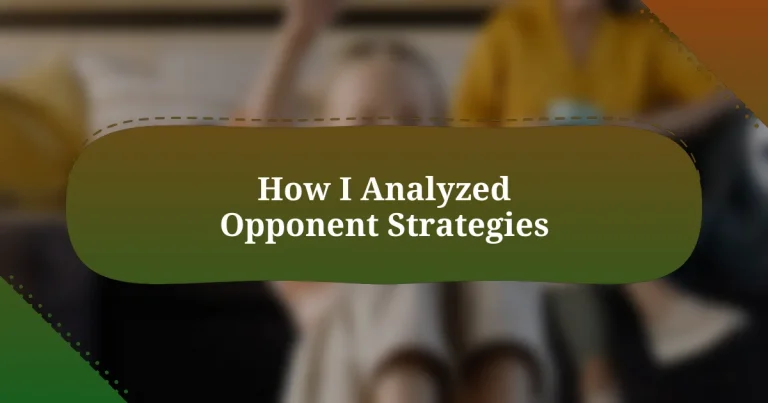Key takeaways:
- Understanding strategies in cricket involves analyzing opponents’ strengths and weaknesses, which can significantly impact the game’s outcome.
- Using tools like video analysis and statistical platforms helps players gain insights into patterns and improve tactical decisions.
- Developing a personal analysis plan and regularly reflecting on observations enhances players’ strategic thinking and adaptability during matches.
- Real-time application of strategies based on analysis can lead to crucial moments that change the dynamics of a game, showcasing the importance of adaptability and responsiveness.
Understanding cricket strategies
When I first began playing cricket, I quickly realized that understanding the strategies behind the game was just as important as mastering the skills. Have you ever noticed how a team’s approach changes depending on their opponent? This shift often comes from carefully analyzing the other team’s strengths and weaknesses, making cricket a game of not just physical prowess but mental acuity as well.
One instance that stands out for me was during a school match where our coach emphasized the importance of field placements. I remember feeling a surge of excitement when I saw our fielders positioned perfectly to catch a powerful shot. Observing how our opponents adjusted their batting in response gave me a deeper appreciation for tactical decision-making. It’s fascinating to think how a single strategic choice can swing the momentum of a game.
Moreover, the art of bowling is as much about dissecting batting techniques as it is about technique itself. I often found myself observing the batter, trying to anticipate their next move. Have you ever felt that rush when you predict a shot correctly? That’s where the thrill lies—understanding patterns in how players approach the game opens up avenues for both offensive and defensive strategies that can change the outcome of a match.
Importance of analyzing opponents
The importance of analyzing opponents in cricket cannot be overstated. When I played in a local tournament, I remember how we meticulously studied the other team’s star bowler. By noticing their bowling patterns, we could prepare our batsmen with tailored strategies to counteract their strengths. Isn’t it rewarding when hard work pays off, and you see your plans unfold on the field?
In another match, I witnessed how understanding the opponent’s weaknesses can turn the tide of a game. We identified a particular batter who struggled against spin. Our captain made the clever decision to bowl spin in key overs, and it was exhilarating to see the plan come into action. Have you ever felt the rush of a game-changing moment shaped by careful planning? That’s the beauty of analyzing your opponents—it’s about predicting and adapting.
Ultimately, the insights gained from analyzing opponents not only equip players with tactical knowledge, but they also foster camaraderie. I fondly remember sharing strategies with teammates after matches, our discussions fueling our passion for the game. It’s amazing how the simple act of observing others can deepen your understanding of cricket, making every match feel like a thrilling chess match played out on the field.
Tools for analyzing strategies
When it comes to tools for analyzing strategies in cricket, video analysis software can be a game-changer. I remember using a simple video app to record matches, and then we’d review key moments together. Watching those clips allowed us to spot crucial details, like a bowler’s subtle changes in grip or a batter’s timing mishaps. Have you ever replayed a moment to uncover something you missed live? It’s a captivating way to learn and improve.
Another effective tool is statistical analysis platforms that provide in-depth player and team metrics. I was always fascinated by how numbers could tell a different story on the field. For instance, using stats to track our opponents’ scoring patterns helped us understand where they found most of their runs. It was like having a secret weapon, right in the stats—who wouldn’t appreciate more insight into their opponent’s game?
In addition to technology, discussing strategies with experienced players can offer invaluable insights. I recall sitting with an older teammate, who shared his wisdom on reading bowler tendencies. His explanations made me realize that sometimes it’s not just about the numbers or the videos; it’s about incorporating the experience and knowledge of those who have walked the path before you. Do you think that blending traditional wisdom with modern tools makes for a more robust strategy? It certainly did for me!
Observing opponent’s gameplay
Observing an opponent’s gameplay is like piecing together a puzzle. I remember the first time I noticed how a rival team consistently changed their batting order based on the type of bowler they faced. It was fascinating to see how their approach varied, and I realized that each player’s strengths came into play in a way that affected the entire match. Have you ever taken a moment to think about how shifts in strategy can completely change the game?
Through observing their body language and shot selections, I could sense when a player was confident or hesitant. There was this one match where I noticed a specific opener who would tighten up anytime he faced our fastest bowler. It was a subtle change, but it gave us the opportunity to exploit that weakness by setting a plan to target him early. This kind of insight can truly tip the scales in your favor.
I’ve learned that paying attention to patterns in the opponent’s gameplay can lead to valuable discoveries. An instance that stands out was when I saw our rivals keep repeating a particular formation during the power play. This clue helped us tweak our strategy to outsmart them. Isn’t it incredible how a small shift in observation can lead to significant improvements in how we play?
Recording key player patterns
Recording key player patterns is crucial to understanding how to approach each match. I recall a specific game where I meticulously tracked a star batsman’s scoring zones over the innings. I found that he tended to favor the leg side, especially when the bowler pitched short. This observation allowed our bowlers to adjust their line and length, leading to crucial breakthroughs. Have you ever considered how much you could gain by simply noting where each player thrives?
One fascinating aspect of player patterns is the rhythm they carry through each innings. I remember a bowler who had a consistent habit of slowing down in the middle overs, possibly due to fatigue or frustration. Recognizing this, we altered our batting strategy to apply pressure during those overs, leading to some quick runs. It’s amazing to think about how small behavioral nuances can have a massive impact on the game dynamics.
Additionally, keeping a record of how players respond to different match situations is enlightening. For instance, I once noticed a lower-order batsman who struggled under high-pressure scenarios but thrived when the match was relaxed. Documenting these insights isn’t just about data; it’s about understanding the human elements of the game. Have you ever delved into how emotional states can influence decision-making on the field?
Developing a personal analysis plan
Developing a personal analysis plan starts with identifying the key elements you want to focus on. I remember sitting down before a series against a rival school. It helped me to create a checklist of specific player tendencies, pitch conditions, and team strategies I wanted to observe. This targeted approach made it easier to see patterns emerge. Have you ever thought about how a structured plan can sharpen your insights?
An effective analysis plan is not just about capturing stats; it’s about shaping your perspective on the game. I once made a point to analyze how my opponents reacted to diverse bowling styles. By observing their behavior against spin versus pace, I could predict which bowlers would be most effective in certain scenarios. It’s truly rewarding to see how planning can lead to a deeper understanding of the match. Have you considered how varying your focus during analysis can illuminate different facets of the game?
Engaging with your analysis plan regularly can amplify its effectiveness. For instance, I used to revisit my notes after every match, reflecting on what worked and what didn’t. Tuning into those moments of reflection, I developed a more intuitive grasp of the game, aiding my ability to adapt strategies in future encounters. How often do you take a step back to evaluate your observations? The insights you gain can transform not only your analysis but also your overall approach to cricket.
Applying strategies in your game
Applying strategies in your game involves using the insights from your analysis to make real-time decisions on the field. I learned this lesson the hard way during a crucial match when I noticed that opposing batsmen struggled with slower deliveries. By adjusting my bowling speed and mixing in some off-spin, I was able to take crucial wickets. Isn’t it amazing how a small shift in strategy can turn the tide of a game?
One of the most rewarding aspects of applying strategies is realizing how they can evolve throughout the match. Early on, I observed that our rivals were attacking aggressively, so I adapted by positioning fielders strategically to curb their scoring. Watching my team’s morale boost as we executed that plan was exhilarating. Have you ever felt that rush when your instincts align with your strategy to successfully outsmart your opponents?
Ultimately, the application of strategies is about being versatile and responsive. I remember a tense moment when our team was down in runs, and I suggested a more defensive approach while batting, focusing on building partnerships. It transformed our innings and lifted our spirits. How often do you embrace changes during a game, trusting your judgment based on analysis? That willingness to pivot might just be your key to success.



